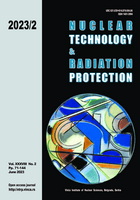
INVESTIGATION OF GAMMA RADIATION SHIELDING FEATURES FOR MODIFIED STRUCTURAL MATERIALS FOR NUCLEAR ENERGY AND NUCLEAR MEDICINE

Vol.
XXXVIII, No. 2, Pp. 71-144
June 2023
UDC 621.039+614.876:504.06
ISSN 1451-3994
Pages: 108-115
Authors: Yuliya Zaripova, Vyacheslav Dyachkov, Tatyana Gladkikh, Mirgul Bigeldiyeva, and Nasr Ahmed Nasr DiabAbstract
In this paper, shielding characteristics of three concrete samples with different B4C, Fe3O4, and BaSO4 contents were examined by determining their theoretical and experimental mass attenuation coefficients at photon energies of 15 MeV. The mass attenuation coefficients µm were theoretically calculated using the chemical compositions of samples with the XCOM program. Then the linear attenuation coefficients µ were calculated by knowing the µm values. Elekta Axesse accelerator was used to experimentally determine the linear attenuation coefficients µ of samples with various impurities. The µ value of 0.4699 cm–1, 0.6072 cm–1, and 0.7194 cm–1 was obtained for the blank sample, sample with magnetite, and sample with barite, respectively, at 15 MeV. The results were compared with coefficients obtained by XCOM and indicated a good agreement between the two methods. The linear attenuation coefficient was evaluated to calculate the half- and tenth-value layers. Compared to conventional concrete, the linear attenuation coefficient for concrete with the highest barite content increased by 53.1 %, and the thickness of the half-attenuation layer decreased by 34.7 %. Such a sample can be used as a building material for medical centers and nuclear power plants.
Key words: concrete, radiation protection, linear attenuation coefficient, half-value layer
FULL PAPER IN PDF FORMAT (1.5 MB)